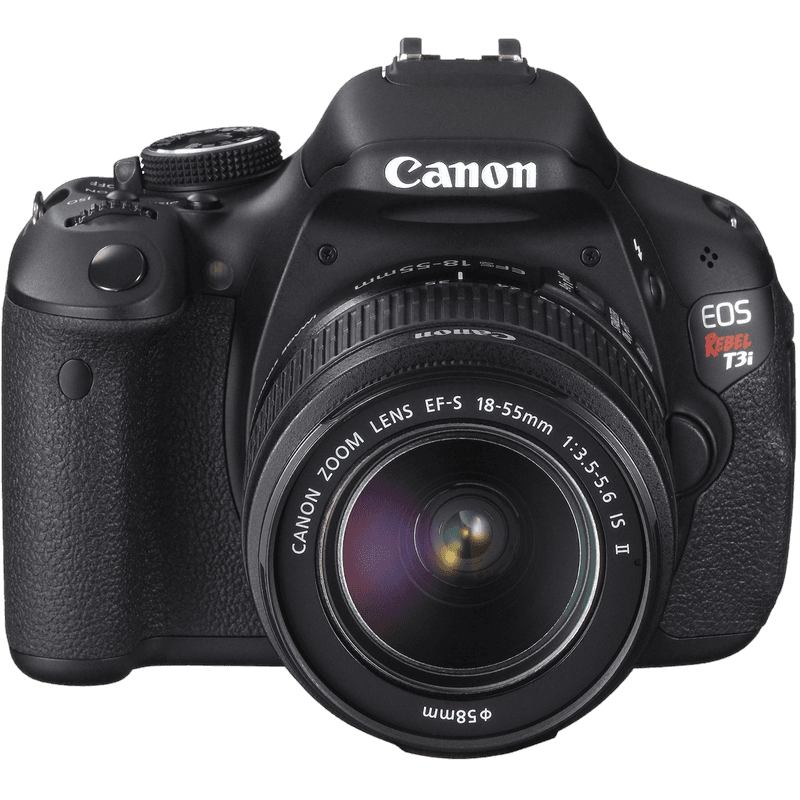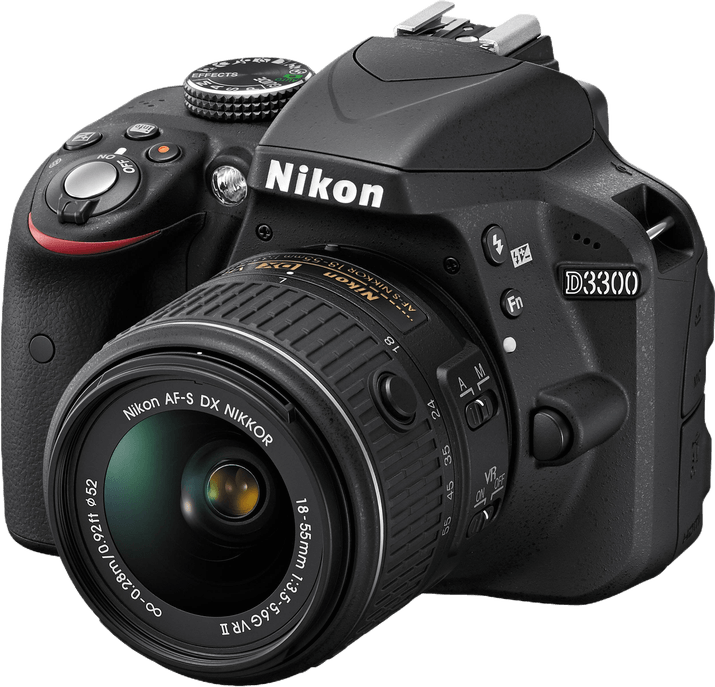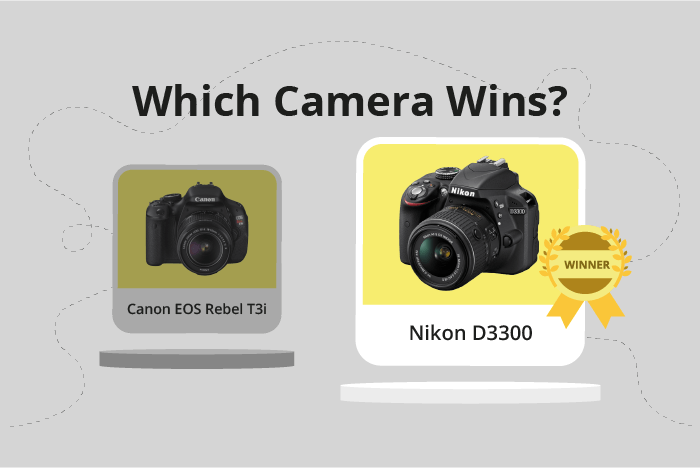Canon EOS Rebel T3i / 600D vs Nikon D3300 Comparison
Canon EOS Rebel T3i / 600D

Nikon D3300

The Nikon D3300 emerges as the winner, scoring 55/100, while the Canon EOS Rebel T3i / 600D trails with a score of 40/100. Both cameras are DSLRs and were released in the early 2010s, with the T3i in 2011 and the D3300 in 2014. They share similarities in size, with the T3i measuring 133 x 100 x 80mm and the D3300 at 124 x 98 x 76mm.
The Nikon D3300 outperforms the Canon T3i with a lower launch price of $650 compared to the T3i’s $850. Additionally, the D3300 is lighter at 430g while the T3i weighs 570g. This makes the Nikon D3300 more affordable and portable.
On the other hand, the Canon T3i has a slightly larger body, which could be advantageous for those with bigger hands or who prefer a more substantial grip. However, this advantage is minimal compared to the Nikon D3300’s benefits.
Taking all factors into consideration, the Nikon D3300 is the better choice due to its affordability and portability.
Canon EOS Rebel T3i / 600D vs Nikon D3300 Overview and Optics
The Nikon D3300 outperforms the Canon EOS Rebel T3i / 600D in optics with a score of 64/100, while the Canon scores 40/100. Both cameras have some common specifications, such as an APS-C sensor size, CMOS sensor type, and the absence of image stabilization. They also have different lens mounts, with the Canon featuring an EF-S mount and the Nikon using an F DX mount.
The Nikon D3300’s superiority is evident in its higher megapixel count at 24.2, compared to the Canon’s 18. This allows for more detailed and higher resolution images. Additionally, the Nikon has a faster shooting speed of 5 frames per second, while the Canon only manages 3.7. The Nikon’s Expeed 4 processor is also more advanced than the Canon’s Digic 4, contributing to better image processing. Furthermore, the Nikon has a higher DXOMARK score for the sensor at 82, compared to the Canon’s 65, indicating better overall image quality.
The Canon T3i / 600D, on the other hand, does not have any specific advantages in optics compared to the Nikon D3300. However, it should be noted that the choice of lenses available for each camera can influence the overall image quality and performance.
Taking these factors into account, it is clear that the Nikon D3300 is the superior camera in terms of optics. Its higher megapixel count, faster shooting speed, more advanced processor, and better sensor performance provide better image quality and overall performance. However, users should also consider the available lenses for each camera when making a final decision on which camera to purchase.
Canon EOS Rebel T3i / 600D vs Nikon D3300 Video Performance
The Nikon D3300 outperforms the Canon EOS Rebel T3i / 600D in video capabilities, scoring 56/100 compared to the T3i’s 43/100. Both cameras share some common video specifications, such as Full HD video resolution and maximum video dimensions of 1920 x 1080. Neither camera has built-in time-lapse functionality.
The Nikon D3300’s higher score is due to its superior video frame rate of 60fps, which is twice the frame rate of the Canon T3i’s 30fps. This higher frame rate allows the D3300 to produce smoother video footage, especially in fast-moving scenes or when capturing sports and action events. This makes the D3300 a better choice for users who prioritize video performance.
On the other hand, the Canon T3i does not offer any significant advantages over the Nikon D3300 in terms of video capabilities. Its lower frame rate of 30fps is still suitable for casual video recording and capturing everyday moments, but it may not be sufficient for more demanding video projects.
Considering the video capabilities of both cameras, the Nikon D3300 emerges as the clear winner due to its higher frame rate and smoother video performance. The Canon T3i is still a decent option for casual video users, but those who require better video performance should opt for the Nikon D3300.
Canon EOS Rebel T3i / 600D vs Nikon D3300 Features and Benefits
The Canon EOS Rebel T3i / 600D wins the features comparison with a score of 44/100, while the Nikon D3300 scores 41/100. Both cameras share some common specifications, such as a 3-inch screen size, no touchscreen, no GPS, no WIFI, and no Bluetooth. However, there are differences that make one camera stand out from the other.
The Canon T3i has a higher screen resolution of 1,040,000 dots, compared to the Nikon D3300’s 921,000 dots. This difference results in a clearer and sharper display on the Canon T3i. Additionally, the Canon T3i has a flip screen, allowing for more flexibility in shooting angles and making it easier for photographers to capture images from various perspectives. This feature is absent in the Nikon D3300.
On the other hand, the Nikon D3300 does not have any distinct advantages over the Canon T3i in terms of features. It shares most of the specifications with the Canon T3i, but lacks the flip screen and has a lower screen resolution.
Taking these points into consideration, the Canon EOS Rebel T3i / 600D is the better option when comparing features. The higher screen resolution and flip screen provide photographers with a more versatile and user-friendly experience. The Nikon D3300, while sharing many of the same specifications, falls short in providing any additional benefits or advantages. Therefore, those looking for a camera with superior features should opt for the Canon EOS Rebel T3i / 600D.
Canon EOS Rebel T3i / 600D vs Nikon D3300 Storage and Battery
The Nikon D3300 outperforms the Canon EOS Rebel T3i / 600D in the storage and battery category, scoring 32 points compared to Canon’s 24 points. Both cameras share some common specifications, such as having a single memory card slot and accepting SD, SDHC, and SDXC memory cards. Neither camera has USB charging capabilities.
The Nikon D3300’s battery life is superior, providing 700 shots per charge, whereas the Canon T3i / 600D only offers 440 shots. This longer battery life makes the Nikon D3300 a more reliable choice for extended shooting sessions. The D3300 uses the EN-EL14a battery type, while the T3i / 600D uses the LP-E8 battery type.
Although the Canon T3i / 600D has a lower score in this category, its storage and battery specifications are still sufficient for most casual users. However, the Nikon D3300’s longer battery life gives it a clear advantage, making it a better choice for those who prioritize extended shooting capabilities.
Alternatives to the Canon EOS Rebel T3i / 600D and Nikon D3300
Are you still undecided about which camera is right for you? Have a look at these popular comparisons that feature the Canon EOS Rebel T3i / 600D or the Nikon D3300:

